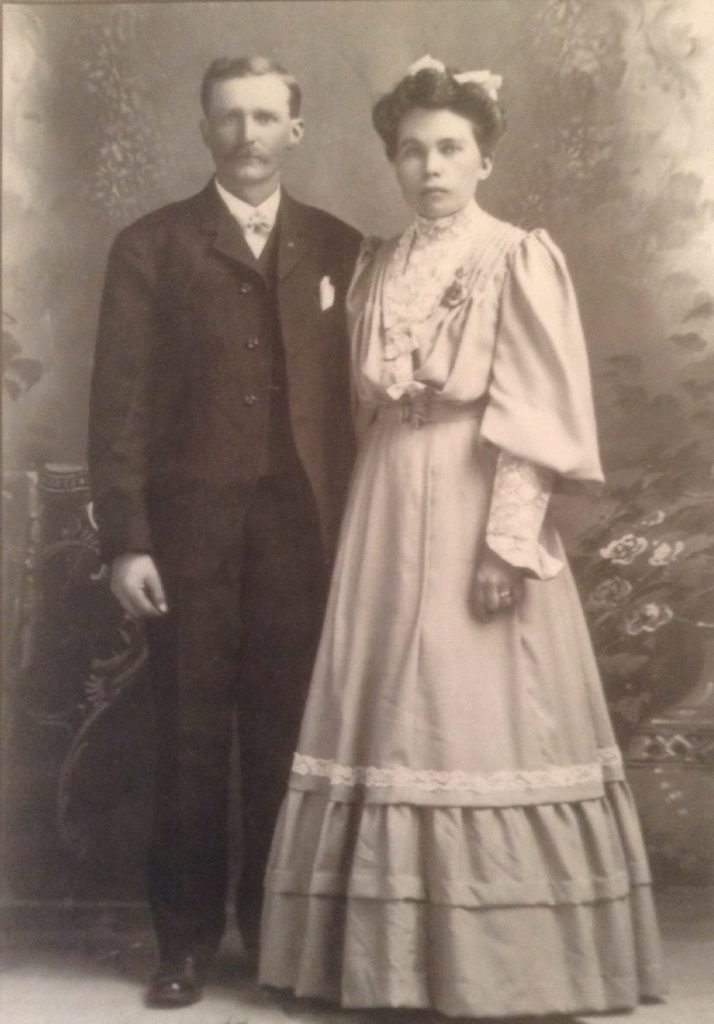
When I posted this photo on Facebook one of my former students asked, Should I put you in contact with the tribal folks they displaced?. That’s a good question. When I told her I wasn’t ready, she gave me snarky response. I can understand that.

When I posted this photo on Facebook one of my former students asked, Should I put you in contact with the tribal folks they displaced?. That’s a good question. When I told her I wasn’t ready, she gave me snarky response. I can understand that.
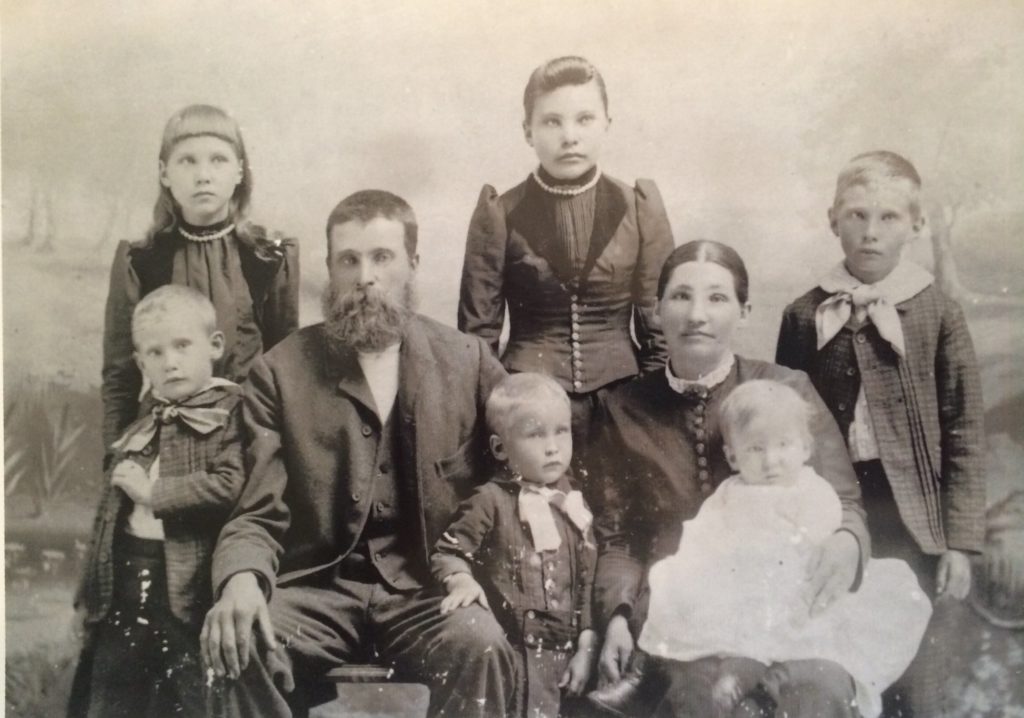
Nils Peter Lif and Lovisa Johansdotter and their kids in Nebraska some time in the late 1880s. The family had arrived in America in 1885 from Vimmerby, Sweden. Nils Peter was my third cousin three times removed.
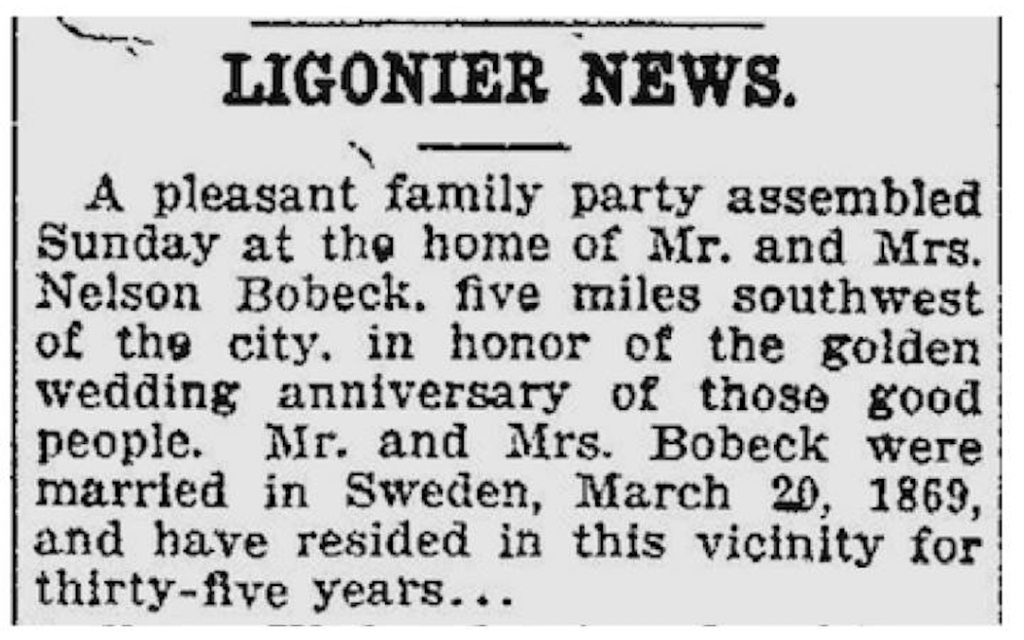
Old Nelson (I’m guessing his given names had been Nils Johan) was my first cousin, three times removed. We’re related through Johanna Hedberg’s father. (Putting that in there as a note to myself.)
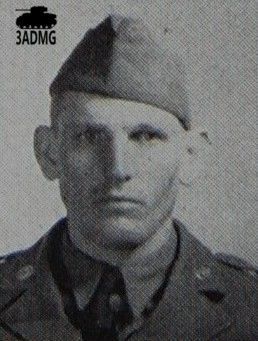
This is my 4th cousin once removed, Private First Class Ralph Victor Freburg, born Sept. 27, 1915 in Bertrand Co., Nebraska. Ralph arrived in France with the 3rd Armored Division on June 24, 1944, and was killed in action on Aug. 17, 1944 in Ranes, Basse-Normandie, France. His family buried him in the Prairie Home Cemetery in Holdrege, Phelps Co., Nebraska. When he signed his draft card in 1940 he had been 6’2″, weighing 185 pounds.
Ralph’s grandfather Anders Victor Andersson had immigrated to Illinois in 1877. He was born in Kristdala, Sweden, in 1850 and died in Nebraska in 1918.
Sandra Olivia was born on November 4th, 1868, in Marka, Skaraborg, Sweden. She was the fourth child and the first daughter of Anders and Maja Christina Grov. When she was about a year and a half, in the summer of 1870, her family emigrated to Jefferson County, Iowa.
In the 1890s, when Zanna Olive Groves was in her 20s, she worked for a few years at the Willow Creek Boarding School on the Blackfeet Indian Reservation west of Browning in northern Montana.
In Montana she met John Edward “Dutch Ed” Trommer, a German immigrant who had come west working on the Northern Pacific Railroad. Olive and Ed married on August 29, 1898, and filed claims for land close to Chester, Montana. They became sheep ranchers and quite successful.
In the fall of 1905 Olive was visiting her parents in Iowa, giving birth to her fifth child. From the Fort Benton River Press, Nov. 29, 1905:
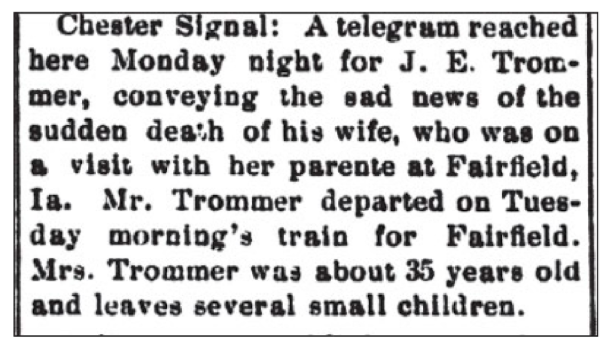
From the Fairfield Daily Journal, Nov. 25, 1905:
“…. This community was shocked Monday evening to hear that Mrs. Ollie Trammer was dead. She had come from her home in Montana with her husband and children two months ago to visit her parents, Mr. and Mrs. A. G. GROVE. The husband had gone back and Mrs. TRAMMER and children remained. A little babe was born three weeks ago and the mother was apparently on the road to recovery. Monday she was bright and hopeful all day, planning when she would be able to return to her Montana home, but about six o’clock she was stricken with heart failure and in half an hour she had gone to her Heavenly home. Messages were sent to the husband and to a brother and sister in Colorado. The deepest sympathy of the entire community goes out to the bereaved husband and parents and to those who cared for her so faithfully and to the five little ones who so much need a mother’s care.”
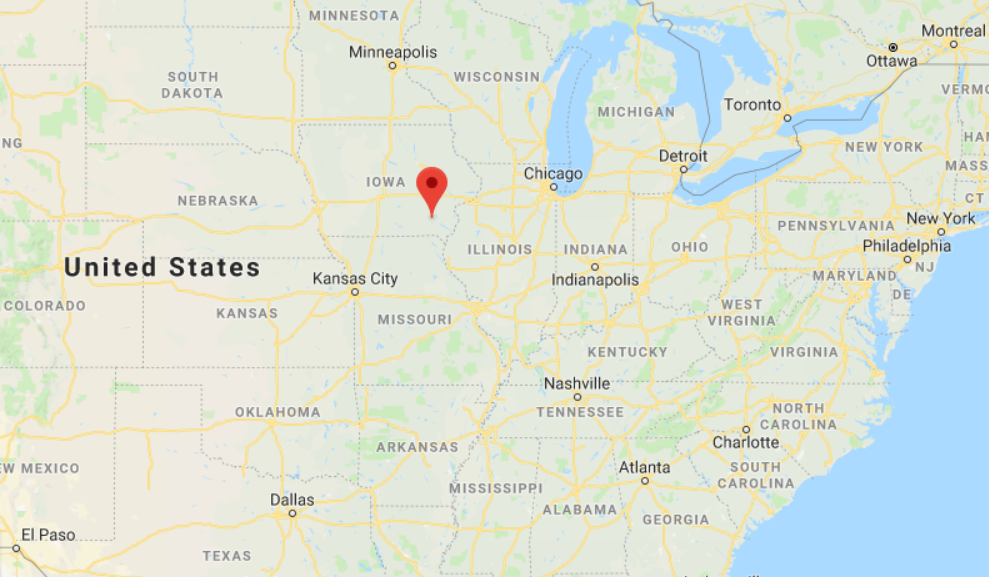
Cedar Township, right outside of Fairfield in Jefferson Co., Iowa, is where Johanna’s older sister Maja Christina ended up with her family. Maja, b. 1842, had married Anders Gustaf Grof in 1860. In 1870 they left Sweden for the US with their four children.

The old map shows 140 acres belonging to A. G. Groves. That’s Maja’s husband, Anders Gustaf. Grof has turned into Grove, or Groves. A little to the west of their property there are 103 acres belonging to Elmer Grove. That’s their son, born in 1874 in Lockridge, Jefferson Co. There are also 100 acres belonging to C. J. Groves. That’s their son Karl Johan, or Charles John. And, there are 40 acres belonging to Groves & Groves. Father and son? Or two sons?
Maja and Anders, or Mary and Andrew, had 12 children. Eight boys and four girls. Many of them continued to farm. All of them were given Swedish first names, but as grown-ups they used American versions of those names.
On Sept. 15, 1915, Alice M. Boov married William N. Kemp in Spring Valley, Rockland Co., NY. Alice used her mother’s maiden name for the records, and her parents are listed as Ada Hedberg and Alfred F. Boov. William is a ‘laborer’, and Alice’s is ‘doing housework’. They live in Thiells, NY. It’s a first marriage for both of them.
A volume of ‘Documents of the Senate of the State of New York’ published in early 1916 includes The Seventh Annual Report of the Board of Managers of Letchworth Village. In it, Alice’s name appears:
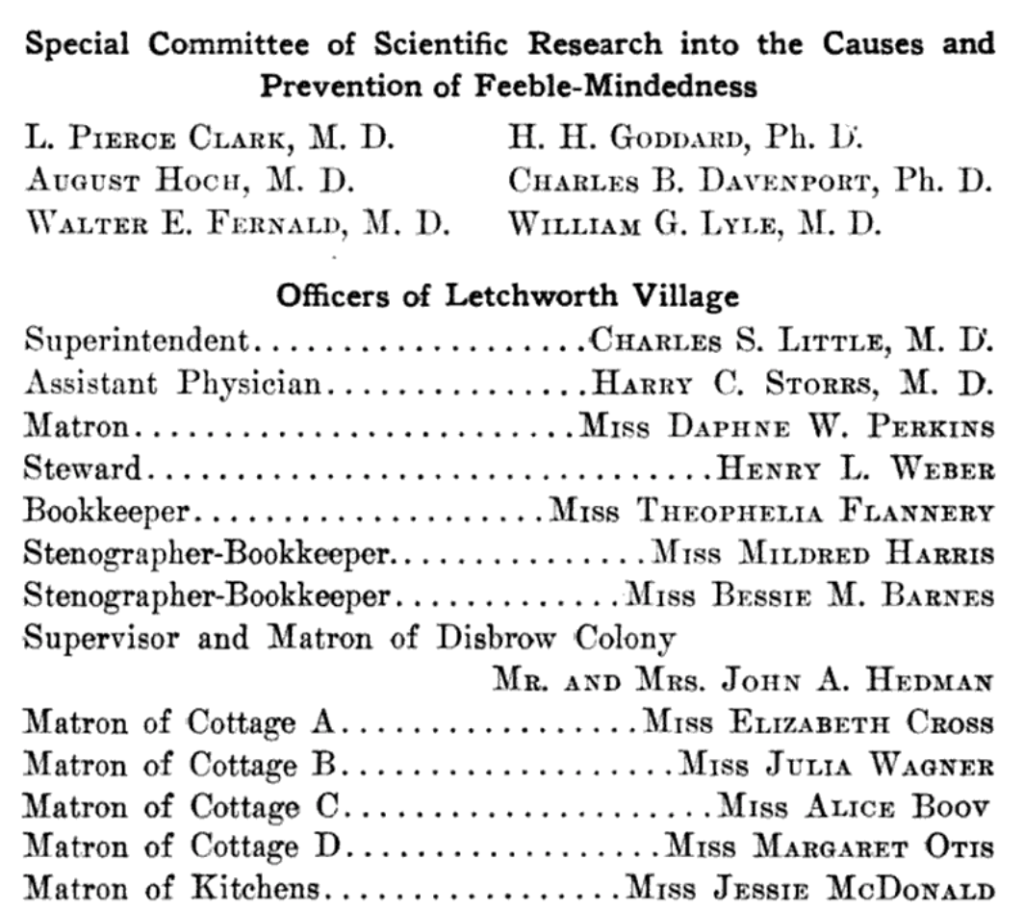
At least during 1915, maybe longer, Alice Boov has worked as Matron of Cottage C, at Letchworth Village in Thiells, NY.
Created by William Pryor Letchworth, Letchworth Village was, according to an article in Hudson Valley Magazine, “a self-contained and self-sustaining village of small cottages on a working farm, which would allow residents a more humane and productive lifestyle under the care of the leading researchers and physicians of the day.”
The patients “were grouped into three then medically accepted but now cringeworthy types of “feeble-mindedness” – “idiot,” “imbecile,” and “moron” – based on IQ. According to their abilities, they helped farm, plow, care for animals, cook, sew, and clean, and were provided vocational training in carpentry, shoe repair, welding, and other useful skills.”
There are horror stories about this place. The patients were used as guinea pigs for the polio vaccine and in other clinical trials. The facility was closed in 1996, and the photos of the buildings are haunting. Online you will find information about tours of the abandoned asylum, as well as of a nearby cemetery with “graves about the size of a child.”

Alice Maria Bååv, my grandfather’s first cousin (their mothers were sisters), left Göteborg for Hull on the s/s Runo on March 17, 1913. From Hull she took the train to Liverpool, and then she left for New York from there.
Alice arrived in Ellis Island on March 30, 1913 onboard the Celtic of Liverpool. She was 5 feet and 7 inches tall, had a fair complexion, brown hair, and blue eyes. She gave the address of a friend, Ingeborg Olsson: 33, W. 12th St., NYC. The old notes are hard to read, but she seems to have had $75 with her. She was of good mental and physical health. She was 25 years old.
From where Alice’s family were living in Bangatan, Göteborg, they could have taken a short walk to the quay, and seen Runo sail away. They lived so close they would have heard and smelled the ocean everyday, before and after Alice left.
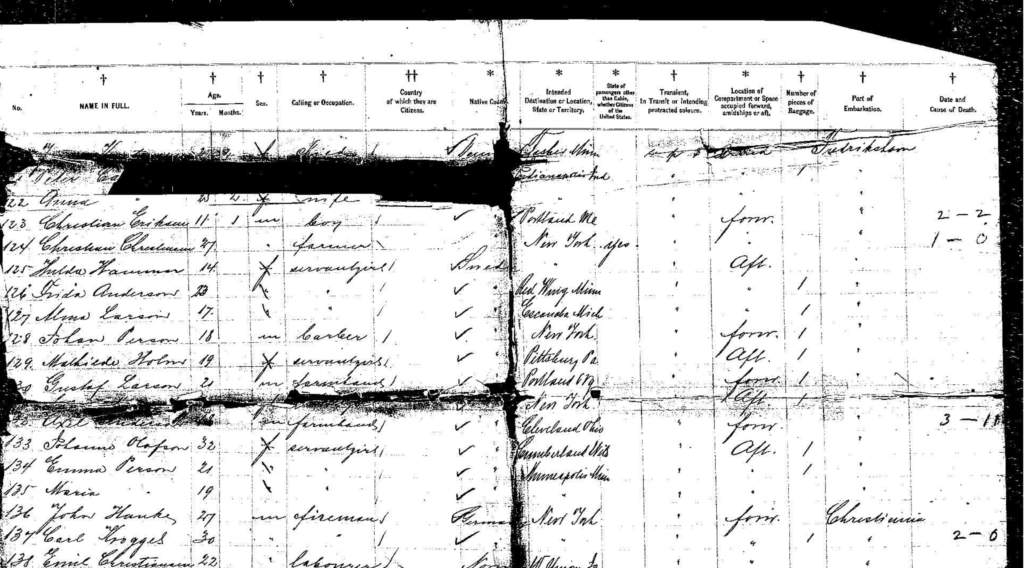
These are notes made at Ellis Island when the s/s Island, the ship that had left Göteborg on June 23, arrived. Passengers are listed as having embarked at Fredrikshavn on the Danish coast across from Göteborg, but we know that some of them had been on the ship since Göteborg. The Swedish passengers are at the top of the page. They are listed in the same order as they were on the manifest taken in Göteborg.
The page is torn where Elna G. Nilson’s name would be, right below Gustaf Larson. Following her line to the right we can see her final destination, New York. Most of the young men are listed as farmhands, and the young women as servant girls. I’m guessing Elna was another servant girl.
Elna had traveled in the aft, rear, of the ship. She brought one piece of luggage. On this part of the page alone four people are listed as having died on the voyage across the Atlantic. The first digit indicates the date, July 1st, 2nd, and 3rd. The second digit is a code for the cause of death. I haven’t been able to figure out what they mean.
My father has told me that his father, Elna’s brother Karl Adolf, was a seasick sea captain. I get seasick too. I wonder what three weeks on a ship across an ocean would have been like.
I hadn’t been able to figure out that Elna’s name had disappeared in the worn fold of the piece of paper if it hadn’t been for more experienced researchers. It seems obvious to compare the names on the list created when they departed from Göteborg to the list that was taken down when they arrived at Ellis Island. But I didn’t think of that. Instead I cursed. The records are well organized, but you never know. The paper trail is important. I needed to know that Elna had arrived in New York, or else I would have lost her.
For a very long time this note was the last I knew of Elna’s whereabouts. She disappeared in New York, into what I imagined was a hot summer day, or a warm summer’s night.

This is the ship manifest listing the names of those traveling from Göteborg to New York on June 23, 1896 on the s/s Island. One of the passengers was Elna G. Nilson from Österåker, Södermanland. Elna was my grandfather’s younger sister. Before emigrating she had been working as a maid on a farm in Österåker. She had been baptized Elma Georgina, but most records have her name is spelled with an ‘n’, Elna.
Elma was born without a known father, but unlike her brother she didn’t use their stepfather’s last name, Kratz. In Sweden in those days you could chose a last name for yourself, no questions asked. Elma picked Nilsson for reasons we will never know. Maybe she knew who her father had been, and wanted to use his name. Maybe she named herself for a friend. Either way, as a teenager she clearly didn’t want anything to do with her stepfather’s name.
On June 22, when the list was created, they hadn’t yet left Göteborg harbor. Anticipating their lives in America one change had already been made: All names ending in -son have had one ‘s’ eliminated. Andersson has become Anderson, Larsson is Larson, and Elma Georgina Nilsson Kratz is now Elna G. Nilson.
All that aside, tho, look how young these emigrants were: 16, 23, 17, 18. Elma was 21.